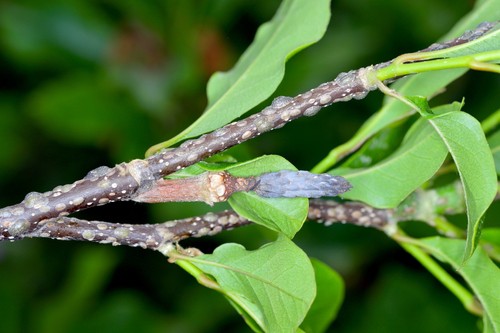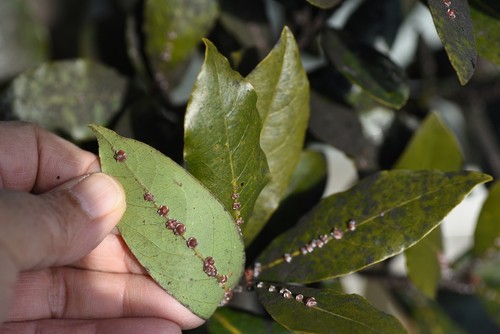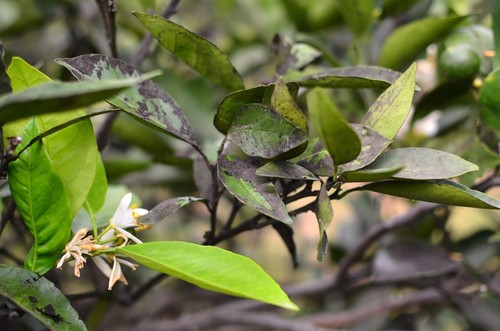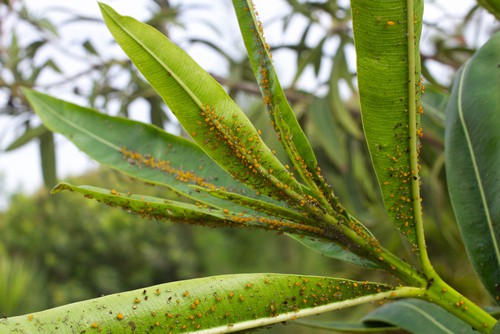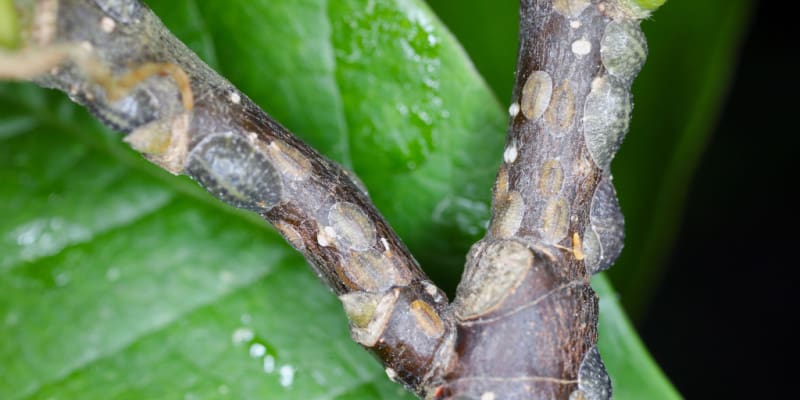
Identifying and controlling scale insects
Our site is reader supported, this means we may earn a small commission from Amazon and other affiliates when you buy through links on our site.
Scale insects seem to be becoming increasingly common year after year, at least in the UK where I’m from where there are over 25 species of them. When I think back to when I first started gardening I never had to deal with them, I’m not sure I’d even seen them. Fast forward over 20 years, and they’re very common. They seem to attack most types of plants including Rhododendrons and Wisteria, and they will also attack many ornamental plants, fruit trees and shrubs.
It’s worth noting that if you scale insects on your wisteria, it’s probably actually the largest species of these insects. Wisteria scale insects are actually approximately 10mm long. Most other scales insects are under 6mm, and there aren’t many plants that don’t succumb to their infestations. The good news is that their numbers can be controlled, mainly by controlling them at the young nymph stage when they actively crawl around. Often you will notice the sticky substance (known as honeydew) first which then leads to black sooty mould.
What are scale insects?
As previously mentioned, scale insects come in various species (about 25 of them) and among the largest of them are those that are drawn to Wisteria plants. Despite their varying sizes, they all have a waxy shell that is somewhat resistant to spray treatments. All the many types of these pests suck the sap from the plant’s leaves for food, and they will feed on the stems and leaves. A serious infestation can cause your plant to die back but most healthy established plants, at least outdoors, with a small group of scales insects shouldn’t be too much cause for concern and can usually just be monitored and treated.
How to recognise these pests
Scale insects can actually be difficult to spot, maybe not quite as difficult as thrips, but because of their small size (with some scale insects only being a few mm long) they can easily be missed. They have a soft body beneath a hard waxy shell and are not often mistaken for anything else. Look at the stems and leaves of your plant, particularly the underside of the leaves. They are more noticeable when they come in a mass to infest your plants, and this is when they do the most damage.
You may, at first, notice that the leaves on your plants are becoming yellow and wilting, and perhaps even falling off the plant.
Scale insects leave behind a clear sweet substance called honeydew that is sticky. Ants love to snack on this food, and it’s a good growing environment for black sooty mould too. So an infestation of ants or a black substance on your leaves could really indicate the presence of scale insects.
How can you control scale insects?
Prevention and Control
Controlling and treating scale insects isn’t necessary if there are just a few of them on your plant. Most healthy plants can handle a few of these insects without coming to any harm. However, because you have noticed them, I would pick off the scale insects by hand to help prevent a further spread. If you have a large infestation then hand-picking them off probably will not be sufficient, and you may need to look for a treatment such as natural oils, or even pesticides as a last resort.
The adult scale insects are actually quite hard to kill because their waxy shell seems to offer them some resistance to most sprays. Because of this, it’s best to control the more vulnerable nymphs that are active, usually around mid-summer. This is where you can break the cycle and actually control the spread of scale insects effectively.
Treatment
Usually, I recommend you start your battle against scale insects with a natural oil spray, such as pyrethrum or another plant oil in mid-summer (May or June) when the insects have just hatched and are at their most vulnerable. You do need to keep reapplying this type of pesticide though because it doesn’t have a long life. And the insect’s waxy shells seem to protect them from the spray. This is why we’re targeting the nymphs as they’re actually scrawling and not forming a waxy protective shell.
There are lots of pesticides to choose from, some contain pyrethrum (such as Clear Gun for Fruit & Veg, Neudorff Bug Free Bug and Larvae Killer) while others contain fatty acids including Doff Greenfly & Blackfly Killer. As an alternative you have the accessibility of using plant oils. Most pesticides labelled for bugs can control scale insects but it doesn’t hurt to find a spray that is specifically labelled for use on scale insects.
Another method I have successfully used on deciduous trees and shrubs is using a winter wash. This is usually applied in the winter, usually around December/January to control the overwintering scale nymphs. I have found this to be very effective and fortunately it’s available in most garden centres.
You can also encourage the natural predators of these insects – ladybirds/ladybugs – to make their home in your garden. This is easier said than done though. However, if you have an issue with scale insects in a greenhouse, I have had success by buying ladybirds online (from Amazon actually) and releasing them into the greenhouse.
For heavier infestation, try an insecticide that contains the organic compound acetamiprid. Bug Clear Ultra is an example of such a spray. Be sure to carefully read the instructions on the bottle though, as these sprays are not selective and will kill any insects they come into contact with, good or bad. This is why I personally try to avoid these types of pesticide sprays.
And, never spray pesticides on plants that are in flower. You may harm bees and other pollinators.
